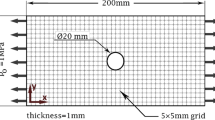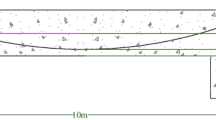Abstract
Considering the size discreteness of commercially available metal plates and the intrinsic buckling strength vulnerability of slender silo, this paper proposed a methodology, which integrated the nonlinear implicit dynamic Finite Element Method (FEM), Particle Swarm Optimization (PSO) algorithm and MATLAB programming, to optimize the wall-thickness layout for stepped thin-walled cylindrical silo, with the objective of minimizing silo mass while ensuring its structural stability. Taking into account both practicality and reliability, silo discharge loads were amplified 1.6 times to try to reflect the comprehensive effectiveness of negative and positive factors on slender silo buckling strength. When evaluating the fitness of PSO method, nonlinear implicit dynamic FEM results, such as kinetic energy history data plots, total energy history data plots, etc., were used to intuitively determine whether silo buckled or not. In essence, the optimal wall-thickness layout problem of a stepped silo is an NP-hard combinational optimization problem. The discrete thicknesses of rolled metal plates set an unavoidable constraint on stepped silo size optimization, which implies that there are only a few specific thickness values could be selected. In addition, the data of plate width are also discrete and one width value might correspond to several thickness data. For reasons for saving the potential cutting costs, the heights of most silo segments should be an integral multiple of the corresponding plate width value as far as possible, while the overall height of the silo should be kept still. To realize this goal, numerical processing techniques, such as generating a random number from a uniformly distributed set of discrete positive integers, linear normalization and linear interpolation, etc., were applied in this study.



























Similar content being viewed by others
References
Rotter JM (2001) Guide for the economic design of circular metal silos. Spon Press, London, New York
Juan A, Moran JM, Guerra MI, Couto A, Ayuga F, Aguado PJ (2006) Establishing stress state of cylindrical metal silos using finite element method: comparison with ENV 1993. Thin-Walled Struct 44(11):1192–1200
Teng JG, Ooi JY, Chen JF (2008) Structures and granular solids: from scientific principles to engineering. Taylor & Francis Group, London
Carson J, Craig D (2015) Silo design codes: their limits and inconsistencies. Proc Eng 102:647–656
Gallego E, Ruiz A, Aguado PJ (2015) Simulation of silo filling and discharge using ANSYS and comparison with experimental data. Comput Electr Agric 118:281–289
Goodey RJ, Brown CJ, Rotter JM (2017) Rectangular steel silos: finite element predictions of filling wall pressures. Eng Struct 132:61–69
Iwicki P, Tejchman J, Chróścielewski J (2014) Dynamic FE simulations of buckling process in thin-walled cylindrical metal silos. Thin-Walled Struct 84:344–359
Iwicki P, Rejowski K, Tejchman J (2015) Stability of cylindrical steel silos composed of corrugated sheets and columns based on FE analyses versus Eurocode 3 approach. Eng Fail Anal 57:444–469
Iwicki P, Sondej M, Tejchman J (2016) Application of linear buckling sensitivity analysis to economic design of cylindrical steel silos composed of corrugated sheets and columns. Eng Fail Anal 70:105–121
Sondej M, Iwicki P, Tejchman J, Wójcik M (2015) Critical assessment of Eurocode approach to stability of metal cylindrical silos with corrugated walls and vertical stiffeners. Thin-Walled Struct 95:335–346
Kuczyńska N, Wójcik M, Tejchman J (2015) Effect of bulk solid on strength of cylindrical corrugated silos during filling. J Constr Steel Res 115:1–17
Chen L, Rotter JM, Doerich C (2012) Practical calculations for uniform external pressure buckling in cylindrical shells with stepped walls. Thin-Walled Struct 61:162–168
Chen L, Rotter JM, Doerich C (2011) Buckling of cylindrical shells with stepwise variable wall thickness under uniform external pressure. Eng Struct 33:3570–3578
Sadowski AJ, Rotter JM (2010) Study of buckling in steel silos under eccentric discharge flows of stored solids. J Eng Mech 136:769–776
Sadowski AJ, Rotter JM (2011) Steel silos with different aspect ratios: II—behavior under eccentric discharge. J Constr Steel Res 67:1545–1553
Sadowski AJ, Rotter JM (2011) Buckling of very slender metal silos under eccentric discharge. Eng Struct 33:1187–1194
Jármai K (2002) Design, fabrication and economy. Eur Integr Stud 1(2):91–107
Farkas J (2005) Structural optimization as a harmony of design, fabrication and economy. Struct Multidiscip Optim 30(1):66–75
Jármai K, Snyman JA, Farkas J (2006) Minimum cost design of a welded orthogonally stiffened cylindrical shell. Comput Struct 84(12):787–797
Bletzinger KU, Ramm E (1993) Form finding of shells by structural optimization. Eng Comput 9(1):27–35
Lindby T, Santos JLT (1999) Shape optimization of three-dimensional shell structures with the shape parameterization of a CAD system. Struct Optim 18(2):126–133
Ansola R, Canales J, Tarrago JA, Rasmussen J (2002) On simultaneous shape and material layout optimization of shell structures. Struct Multidiscipl Optim 24(3):175–184
Dai L, Guan ZQ, Chen BS, Zhang HW (2008) An open platform of shape design optimization for shell structure. Struct Multidiscipl Optim 35(6):609–622
Liua M, Xing M, Yang QS, Yang XM (2012) Computational morphogenesis of free form shell structures by optimization. Proc Eng 31:608–612
Perez RE, Behdinan K (2007) Particle swarm approach for structural design optimization. Comput Struct 85(19–20):1579–1588
Jármai K (2007) Single- and multiobjective optimization of a welded stringer-stiffened cylindrical shell. Periodica Polytechnica: Civ Eng 51(2):11–18
Vu VT (2010) Minimum weight design for toroidal pressure vessels using differential evolution and particle swarm optimization. Struct Multidiscipl Optim 42(3):351–369
Rao AR, Shyju PP (2010) A meta-heuristic algorithm for multi-objective optimal design of hybrid laminate composite structures. Computer-Aided Civ Infrastruct Eng 25(3):149–170
Lagaros ND, Papadrakakis M (2012) Applied soft computing for optimum design of structures. Struct Multidiscipl Optim 45(6):787–799
Cai X, Zhu J, Pan P, Gu R (2012) Structural optimization design of horizontal-axis wind turbine blades using a particle swarm optimization algorithm and finite element method. Energies 5(11):4683–4696
Chen J, Tang Y, Ge R, An Q, Guo X (2013) Reliability design optimization of composite structures based on PSO together with FEA. Chin J Aeronaut 26(2):343–349
Jiang W, Lin Y, Chen M, Yu Y (2015) Research on the optimization approach for cargo oil tank design based on the improved particle swarm optimization algorithm. J Shanghai Jiaotong Univ (Sci) 20(5):565–570
Foryś P (2015) Optimization of cylindrical shells stiffened by rings under external pressure including their post-buckling behavior. Thin-Walled Struct 95:231–243
Szczepanik M, Poteralski A, Kalinowski M (2016) Optimization of the shell compliance by the thickness changing using PSO. IOP Confer Ser Mater Sci Eng 161(1):012018
Vu VT (2016) Minimum weight design for toroidal shells with strengthening component. J Press Vessel Technol Trans ASME 138(2):021202/1–021202/7
Sun W, Cheng W (2017) Finite element model updating of honeycomb sandwich plates using a response surface model and global optimization technique. Struct Multidiscipl Optim 55(1):121–139
Kennedy J, Eberhart R (1995) Particle swarm optimization. Proc IEEE Int Confer Neural Netw 4:1942–1948
Eberhart R, Kennedy J (1995) A new optimizer using particle swarm theory. In: Proceedings of the sixth international symposium on micro machine and human science, pp 39-43
Kennedy J (1997) The particle swarm: social adaptation of knowledge. In: Proceedings of IEEE international conference on evolutionary computation, pp 303–308
Shi Y, Eberhart R (1998) A modified particle swarm optimizer. In: Proceedings of the IEEE international conference on evolutionary computation, pp 69–73
Angeline RJ (1998) Evolutionary optimization versus particle swarm optimization: philosophy and performance differences. In: Proceeding of the 7th international conference on evolutionary programming, pp 601–610
Eberhart R, Shi Y (2001) Particle swarm optimization: developments, applications and resources. In: Proceedings of the IEEE congress on evolutionary computation, pp 81–86
Shi Y, Eberhart R (1998) Parameter selection in particle swarm optimization. Evolutionary programming VII. Lecture Notes Comput Sci 1447:591–600
Pedersen M, Chipperfield A (2010) Simplifying particle swarm optimization. Appl Soft Comput 10(2):618–628
Eberhart R, Shi Y (1998) Comparison between genetic algorithms and particle swarm optimization. In: Proceeding of the 7th international conference on evolutionary programming, pp 611–616
Luh G, Lin C (2011) Optimal design of truss-structures using particle swarm optimization. Comput Struct 89(23–24):2221–2232
Volke S, Middendorf M, Hlawitschka M, Kasten J, Zeckzer D, Scheuermann G (2013) dPSO-Vis: topology-based visualization of discrete particle swarm optimization. Comput Gr Forum 32(3):351–360
Pradeepmon T, Panicker V, Sridharan R (2016) Parameter selection of discrete particle swarm optimization algorithm for the quadratic assignment problems. Proc Technol 25:998–1005
Zouache D, Nouioua F, Moussaoui A (2016) Quantum-inspired firefly algorithm with particle swarm optimization for discrete optimization problems. Soft Comput 20(7):2781–2799
Jordehi A, Jasni J (2015) Particle swarm optimisation for discrete optimisation problems: a review. Artif Intell Rev 43(2):243–258
Li L, Huang Z, Liu F (2009) A heuristic particle swarm optimization method for truss structures with discrete variables. Comput Struct 87(7–8):435–443
Kaveh A, Talatahari S (2009) A particle swarm ant colony optimization for truss structures with discrete variables. J Constr Steel Res 65(8–9):1558–1568
Shojaee S, Arjomand M, Khatibinia M (2013) A hybrid algorithm for sizing and layout optimization of truss structures combining discrete PSO and convex approximation. Int J Optim Civ Eng 3(1):57–83
Yang B, Zhang Q, Li H (2015) Solving truss topological optimization with discrete design variables via swarm intelligence. KSCE J Civ Eng 19(4):952–963
Cheng M, Prayogo D, Wua Y, Lukito M (2016) A hybrid harmony search algorithm for discrete sizing optimization of truss structure. Autom Constr 69:21–33
Yang I, Hsieh Y, Kuo C (2016) Integrated multiobjective framework for reliability-based design optimization with discrete design variables. Autom Constr 63:162–172
Acknowledgements
The R & D center of MESNAC Co., LTD, a global rubber machinery provider in Qingdao, China, is gratefully acknowledged for providing the computing resources related to this work.
Author information
Authors and Affiliations
Corresponding author
Additional information
Publisher's Note
Springer Nature remains neutral with regard to jurisdictional claims in published maps and institutional affiliations.
Rights and permissions
About this article
Cite this article
Tian, Z., Jiao, D. Discrete sizing optimization of stepped cylindrical silo using PSO method and implicit dynamic FE analysis. Engineering with Computers 37, 1015–1047 (2021). https://doi.org/10.1007/s00366-019-00870-6
Received:
Accepted:
Published:
Issue Date:
DOI: https://doi.org/10.1007/s00366-019-00870-6




